6 December, 2003
Lower Erebus Hut
After two days acclimatizing at Fang Camp, weve finally made it up to
the Lower Erebus Hut. Our first day here was eventful, setting up tents,
reacquainting ourselves with the other half of our team, and exploring
the nearby ice caves. The air is definitely thinner at altitude!
Everything seems to take a lot more effort from setting up a tent to
walking between the hut and your tent. But it is absolutely beautiful
here! The days been clear and bright and it was well worth the long
wait in McMurdo.

1. Figure 1 Saturday was another crisp and clear day with a few puffy clouds and a nice plume from Erebus. Not only was it sunny and bright, but we were actually hot in our Scott tents, prompting us to slather on sunscreen and climb out to wait for the helicopter to take us to the Lower Erebus Hut.
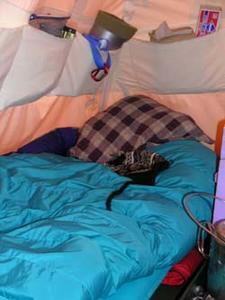
2. Figure 2 We slept warmly last night due in part to the 55 degree down sleeping bags and two layers of sleeping pads. Note the red in the bottom right corner of the picture. This is my big, red parka. Tucked in between sleeping pads, the parka provides extra insulation from the ground, as well as nice cushioning. Other clothes get tucked into the foot of my sleeping bag to keep them from freezing. A water bottle full of boiling water helps to keep the bag toasty all night.

3. Figure 3 A two burner Coleman stove also helps to heat up the tent (note pots on stove to the bottom left). While we are awake in the tent, we keep a pot of water boiling for drinks and hot water bottles. Melting ice for drinking water takes is time consuming as the icy snow is porous (lots of air spaces) and a large piece produces just a little water.
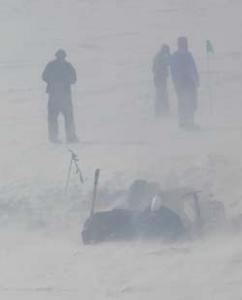
4. Figure 4 The helicopter arrived to shuttle us to the Lower Erebus Hut at 1:30 PM. Our beautiful sunny day turned into a temporary whiteout kicked up by the propeller wash.
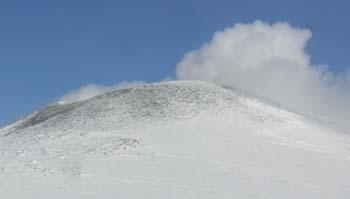
5. Figure 5 I got my first good view of the upper crater from the helicopter. The plume was pumping away and I could smell the distinctive sulfur odor when I landed at Lower Erebus Hut.
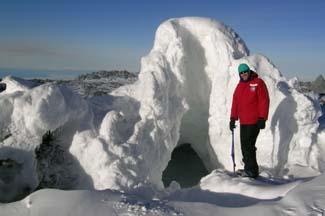
6. Figure 6 After dinner we explored nearby Hut Cave. Ice caves form at the base of ice towers. The towers themselves are formed where warm, moist gas is vented on the sides of the volcano. The water vapor freezes as soon as it contacts the cold air, building the tower. The caves underneath are relatively warm and moist, some reaching almost 90 degrees Fahrenheit (about 32 C).
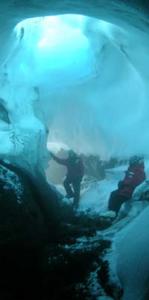
7. Figure 7 The light inside the cave is eerily beautiful, tinted blue as it filters through the ice. Some passages in the cave are quite large, floored with volcanic rock and capped by ice.
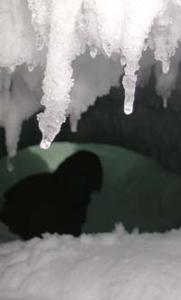
8. Figure 8 Much like limestone caves, ice caves have their own interesting formations such as these icicles that closely resemble stalactites. Other areas of the cave contain ice formations resembling the calcite flowstone, stalagmites, and pillars found in rock caves.
Contact the TEA in the field at
.
If you cannot connect through your browser, copy the
TEA's e-mail address in the "To:" line of
your favorite e-mail package.
|
